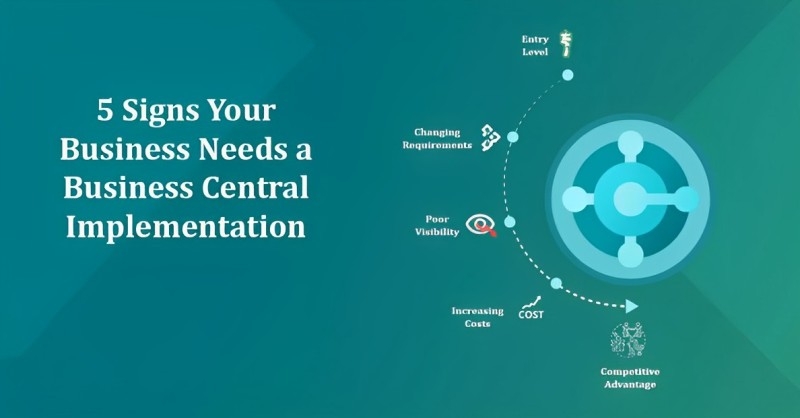In the speedy and steadily developing scene of business technology, remaining ahead isn’t simply a benefit but a need. As we step into 2025, the requirement for effective and consistent business tasks has never been more critical. One key solution that keeps on acquiring importance is Business Central Microsoft’s complete business management solution. In this extensive guide, we’ll investigate the complexities of Business Central implementation in 2025, revealing insight into the most recent patterns, best practices, and procedures for an effective organization.
Figuring out Business Central
Prior to diving into the execution interaction, it’s essential to have an unmistakable comprehension of what Microsoft dynamics 365 business central is and how it can change your business. Business Central is a comprehensive Enterprise Resource Planning (ERP) solution that coordinates different business processes, including finance, tasks, sales, and client assistance. Business Central has changed in 2025 to be easier to use, more scalable, and more able to meet the specific requirements of different industries.
Key Elements and Advantages
In the most recent adaptation of Business Central Microsoft has presented a few new elements and upgrades to enhance Business Central implementation. These incorporate high-level examination, AI-driven bits of knowledge, further developed safety efforts, and improved cooperation apparatuses. Understanding these highlights is essential for utilizing the maximum capacity of Business Central and guaranteeing a smooth execution.
Advanced Analytical Tools:
The consideration of undeniable level examination in Business Central 2025 addresses a huge jump forward in business knowledge. With the force of cutting-edge investigation, organizations can acquire further bits of knowledge about their tasks, client conduct, and market patterns. Users can make data-driven decisions with precision and confidence thanks to the dynamic dashboards and customizable reports provided by the system’s analytical tools. This component is particularly crucial in a quickly changing business climate, where the capacity to adjust quickly is inseparable from progress.
AI-Driven Bits of Knowledge:
Through AI calculations, Business Central can examine verifiable information, anticipate future patterns, and robotize dull errands. This upgrades functional proficiency as well as enables organizations to go with informed choices in view of prescient examination. As organizations explore the vulnerabilities of the market, having AI-driven experiences available to them turns into an upper hand.
Extraordinary Security Measures:
In a time of expanding digital dangers, information security is vital. Business Central 2025 has strengthened its security measures as a result. The most recent form consolidates progressed encryption conventions, multifaceted verification, and consistent observing to shield delicate business information. The improved security highlights safeguards against outer dangers as well as alleviates the dangers related with interior information breaks.
Further developed Cooperation:
The 2025 form presents upgraded coordinated effort apparatuses that work with consistent correspondence and collaboration. With highlights like ongoing report sharing, cooperative altering, and coordinated correspondence channels, Business Central advances a strong and associated workplace. This is especially helpful in today’s dynamic workplace, where virtual teams and remote collaboration are becoming more and more common.
Coordination with Microsoft 365:
Perceiving the significance of a brought-together computerized environment, Business Central has fortified its coordination with Microsoft 365. This coordination smoothes out correspondence, record sharing, and cooperation by uniting Business Central’s ERP capacities with the efficiency instruments of Microsoft 365. Clients can consistently progress between applications, guaranteeing a smooth and productive work process. This collaboration improves efficiency as well as adds to a more easy-to-use and durable client experience.
5 Signs Your Business Needs a Business Central Implementation
Most growing businesses eventually hit limits as makeshift systems start dragging operations instead of powering growth.
Planning for Implementation
An effective Business Central implementation starts with careful training. This section will direct you through the preliminary stage, covering perspectives, for example,
Needs Testings: Recognize the particular requirements and difficulties of your business that Business Central will address.
Data Migration: Foster a powerful migration procedure to guarantee a consistent change from existing frameworks to Business Central.
Group Training: Invest in comprehensive training programs to give your team the skills they need to use Business Central to its full potential.
Choosing the Right Implementation Partner
Choosing the right implementation partner is a crucial choice that will have a big effect on whether or not your Business Central implementation goes well. In 2025, organizations are progressively going to accomplish this with a demonstrated history, industry mastery, and a profound comprehension of the most recent innovation patterns. The most important things to look for in an implementation partner, such as their experience, reviews from previous clients, and their capacity to tailor solutions to your specific needs.
Customization and Combination
Business Central’s solidarity lies in its capacity to adjust to the particular requirements of every business. In 2025, customization has become more natural and easy to understand.
Customization in Business Central (2025):
Easy to use Interface: Business Central’s customization interface has been redesigned to be easier to use and more intuitive, making it easier for businesses to make changes.
Adaptable Workflows: Organizations can fit Business Vital to their particular work processes, guaranteeing that the ERP arrangement adjusts flawlessly with their novel cycles and necessities.
Custom Fields and Information Types: The most recent rendition permits clients to make custom fields and information types, giving a serious level of adaptability in catching and overseeing business-explicit data.
Job Driven Customization: Customization choices are job driven, permitting organizations to give fitted encounters to various client jobs inside the association.
Upgraded Announcing and Dashboards: Organizations can now make customized reports and dashboards, introducing information in a way that is generally significant for their dynamic cycles.
Integration Prospects:
- Microsoft 365 Integration
- Integration of Third-Party Apps.
- Integration of API
- E-commerce Coordination:
- IoT Combination
- Inheritance Framework Reconciliation
How to Build a Cohesive Tech Stack:
- Define the Integration Goals. Obviously, frame the goals of reconciliation to guarantee that the innovation stack lines up with the general business system.
- Stay up with the latest with standard support, guaranteeing that they keep on working flawlessly and safely.
- Carry out strong information safety efforts to safeguard data as it streams between coordinated frameworks, keeping up with the respectability and classification of delicate information.
- To get the most out of a technology stack that works together, give users comprehensive training on both Business Central and the tools that are integrated.
- Ceaselessly screen the presentation measurements of incorporated frameworks, resolving any issues immediately to keep a smooth and productive activity.
- Pick coordination arrangements that are versatile to oblige the development and advancing requirements of the business without significant interruptions.
Execution Interaction
With the basis laid, now is the ideal time to plunge into the genuine Business Central implementation. This section will give a step-by-step manual for the execution interaction, covering:
- Configuration and installation: Make sure that Business Central is set up in a way that meets your company’s needs.
- Data Migration and Approval: Execute the information movement plan, guaranteeing information precision and trustworthiness.
- Adoption and training of users: Direct extensive instructional courses for end-clients to speed up reception and limit disturbances.
- Go-Live and Post-Implementation Backing: Consistently change to Business Central and offer continuous help to resolve any issues that might emerge.
Defeating Normal Difficulties
Indeed, even with cautious preparation, difficulties might emerge during the execution stage. Some normal obstacles faced by organizations are, for example, being rigid to change, unforeseen technical issues, and data irregularities. Methodologies for defeating these difficulties and guaranteeing a smooth execution should be examined, drawing on genuine models and industry best practices.
Ceaseless Improvement and Redesigns
The universe of business innovation is dynamic, and arrangements like Business Central are ceaselessly advancing. To stay ahead in 2025, you must adopt a culture of continuous improvement. Organizations should learn the most proficient method to screen execution, accumulate client criticism, and influence customary updates and redesigns from Microsoft to guarantee that Business Central’s remaining parts a strong and future-confirmation solutions long into the future.
Conclusion:
The environment is both exciting and challenging as we begin the implementation of Business Central in 2025. Businesses can take full advantage of this comprehensive ERP solution with the right knowledge, preparation, and strategic partnerships. This ultimate guide expects to be a compass, exploring you through the complexities of Business Central implementation, and assisting you with building an establishment for progress and future development in the consistently developing business scene.
Read More:
- How can I validate Export a CSV File from my business app?
Exporting a CSV file and performing posting validations before using Microsoft Dynamics 365 Business Central involves several steps.



